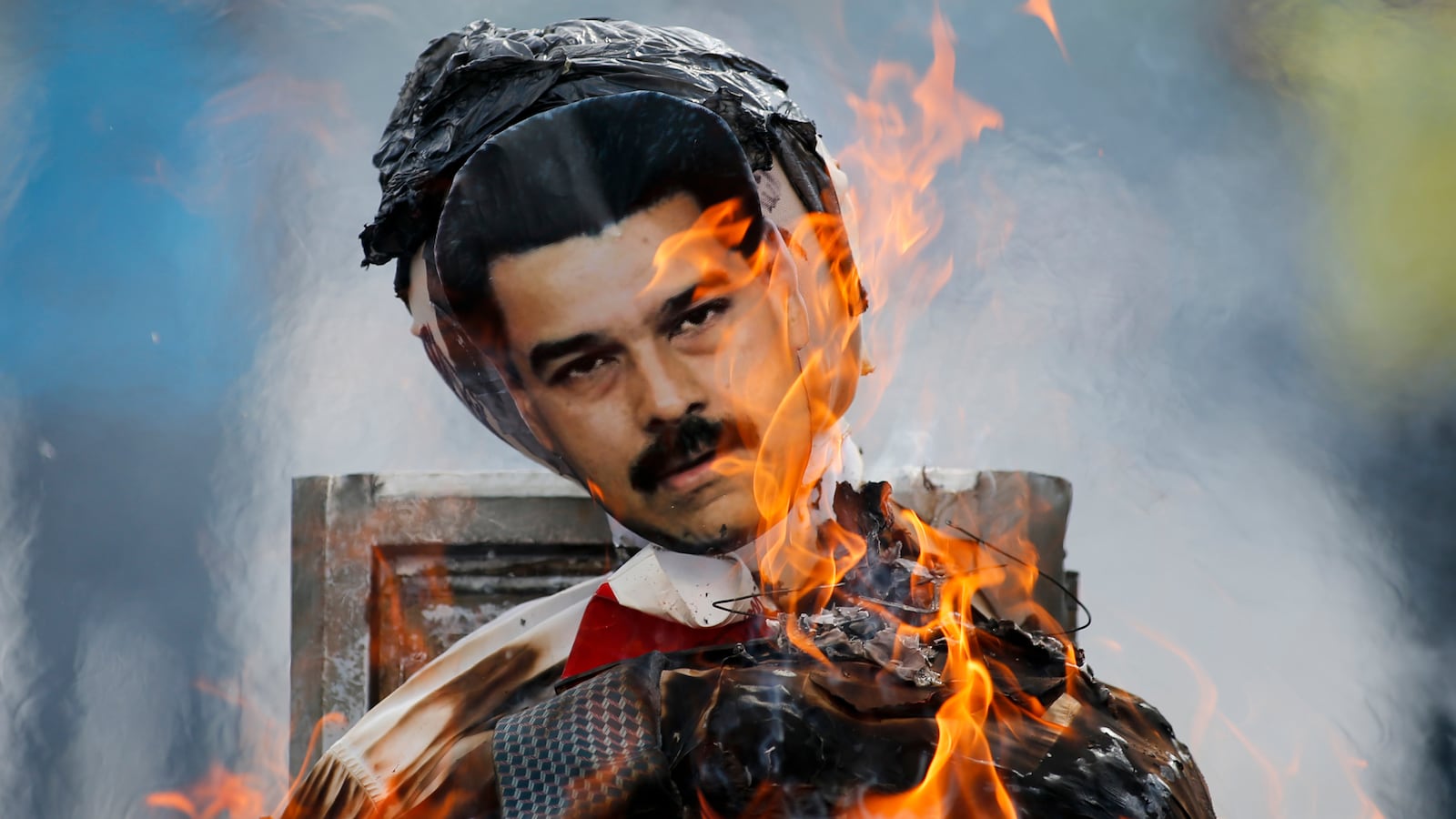Longstanding tradition in Venezuela calls for “Judas burning” on Easter Sunday. People make giant dolls out of old clothes and set them ablaze, remembering the betrayal of Christ. Often, Judas is given the face of a contemporary politician, and this year effigies of President Nicolás Maduro went up in flames amid resounding cheers in the opposition bastions of Caracas, Carabobo, Táchira and Mérida.

After a few weeks of relative calm, once again those streets are filled with teargas and the police are blasting away at demonstrators with plastic and metal pellets. But, in truth, the crowds are small, injuries now are few and even the angriest have grown weary of a game that seems to be going nowhere.
For almost six weeks, from February 12 to March 24, there was about one death a day in anti-government demonstrations, 39 people killed altogether. In the four weeks since, two more have died. The military is encouraging the public to turn the page, as if all the deaths were somehow accidental; as if those responsible will be punished; as if Venezuela’s massive economic and political problems are on their way to being solved. But, of course, none of those propositions is true.
When Gen. Vladimir Padrino, the powerful head of the Strategic Operational Command, told a television audience last month that “no soldiers have received orders to harm anyone, nor to harass or end any Venezuelan’s life,” Rosa Orozco barely paid attention. She was still in mourning for her daughter.
Twenty-three-year-old Geraldine Moreno had been protesting peacefully in Carabobo—a state in the north of Venezuela—when National Guard troops arrived and fired metal shotgun pellets at the demonstrators.
“They came riding on 10 motorcycles, two officers on each one,” Orozco remembers. “They had the uniform, the mandatory weaponry, and there was even a woman among those who shot.”
The guns are meant to be fired from a distance so the birdshot spreads out in a wide pattern after it leaves the barrel, and that’s what happened at first. The pellets hit Moreno in her face—not the torso, not her legs—and then when she was bleeding on the ground “an officer shot from four inches away,” her mother says, so the pellets never spread and the whole cartridge blew clean through Moreno’s face. She instantly lost her left eye and eventually died on February 22.
Orozco is still crying out for justice. But after two months nobody has been held responsible. “We’ve done everything,” she says, “but there are high-level officers involved in the killing and the public ministry hasn’t released the files. Can you believe it?”
In Venezuela, sadly, anyone would believe it.
At the height of the protests an engineer was beaten to death by National Guard troops on the road to a hospital. A crazy firefight started by a bodyguard of the “peace” minister ended with a bullet in a student’s head. A 20-year-old cook was detained for threatening national security, but no proofs whatsoever were presented in court. Four guys were tortured with electricity applied to their testicles. In one jail where people were detained illegally the wakeup call was made with teargas bombs.
Gen. Padrino is a powerful member of the military and during the same TV show he assured the audience that these days torture and abusive behavior are the exception. He claimed 97 officers are under investigation. But it’s not known if Moreno’s killer is part of that group, and even if he is, there’s little likelihood of punishment. Amnesty International noted in a recent report looking at 50 cases of torture that although officers are detained, there’s no evidence that charges have been formally presented.
Padrino has aligned himself politically with the official version of the riots in which protesters supposedly are financed by the United States to overthrow Maduro. But if so, he does not seem concerned. He knows that in the real world the trends are moving now in favor of the military. According to private and public polls significant majorities disapprove of the president, of the protests and of the military repression. But as long as the military has the guns, it doesn’t need to worry so much about its numbers, and Venezuelan history shows a predilection for strongmen in uniform. That was how Lt. Col. Hugo Chávez came to power. And the 40 years before that, when civilians limited martial influence, now seem very dim memories indeed.
A case such as Moreno’s death might well lead to resignations if it took place in the United States, but in Venezuela not a single commander has been affected, and as her mother puts it, “there’s no way we can trust police or military anymore.” Orozco says that when she demands the military and police files in her daughter’s case, “They don’t come up with excuses anymore. They just look to the floor and mumble.” Time, they believe, is on their side.
When the civilian President Maduro burns in effigy, soldiers can still warm their hands around the flames.






